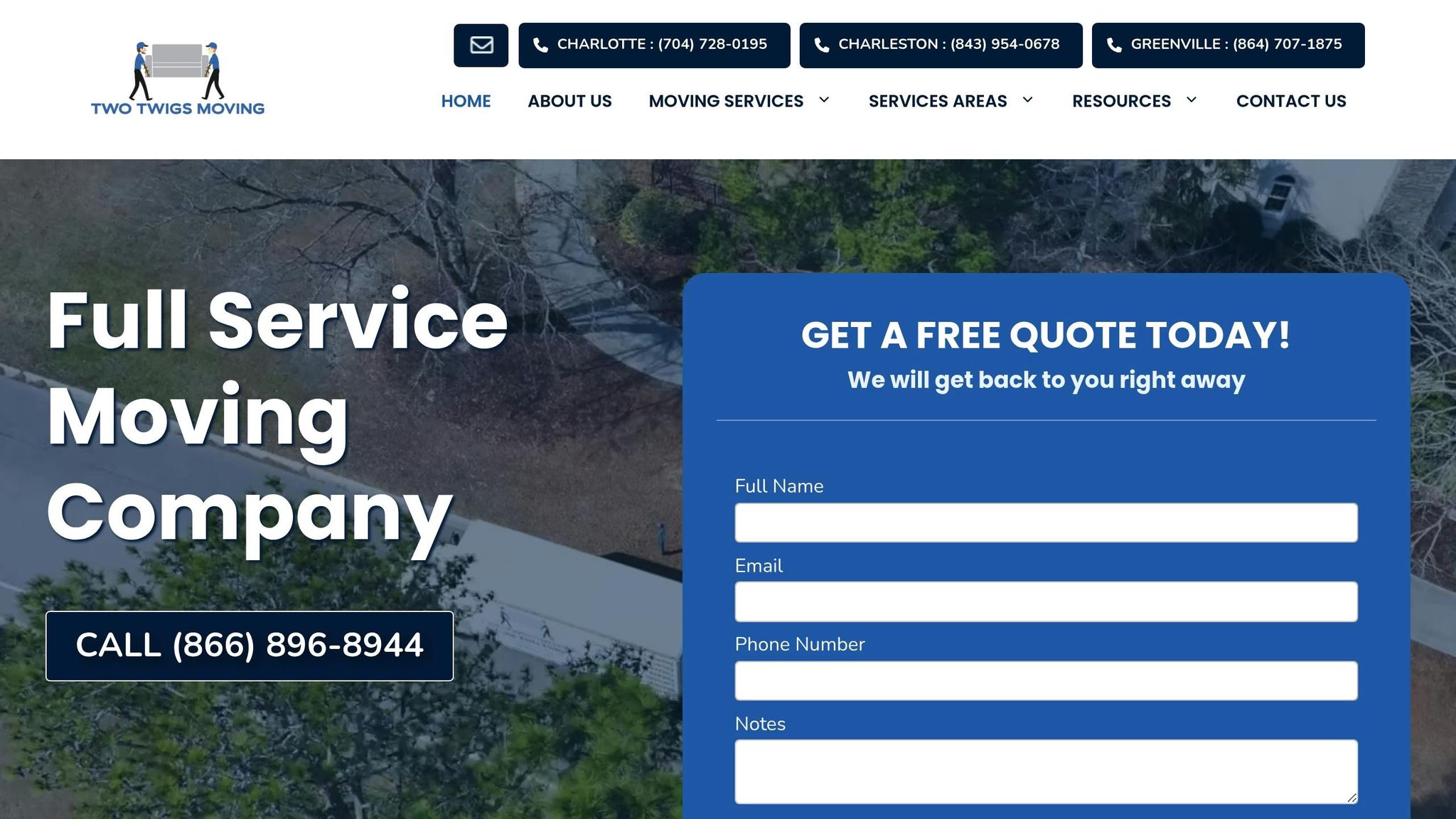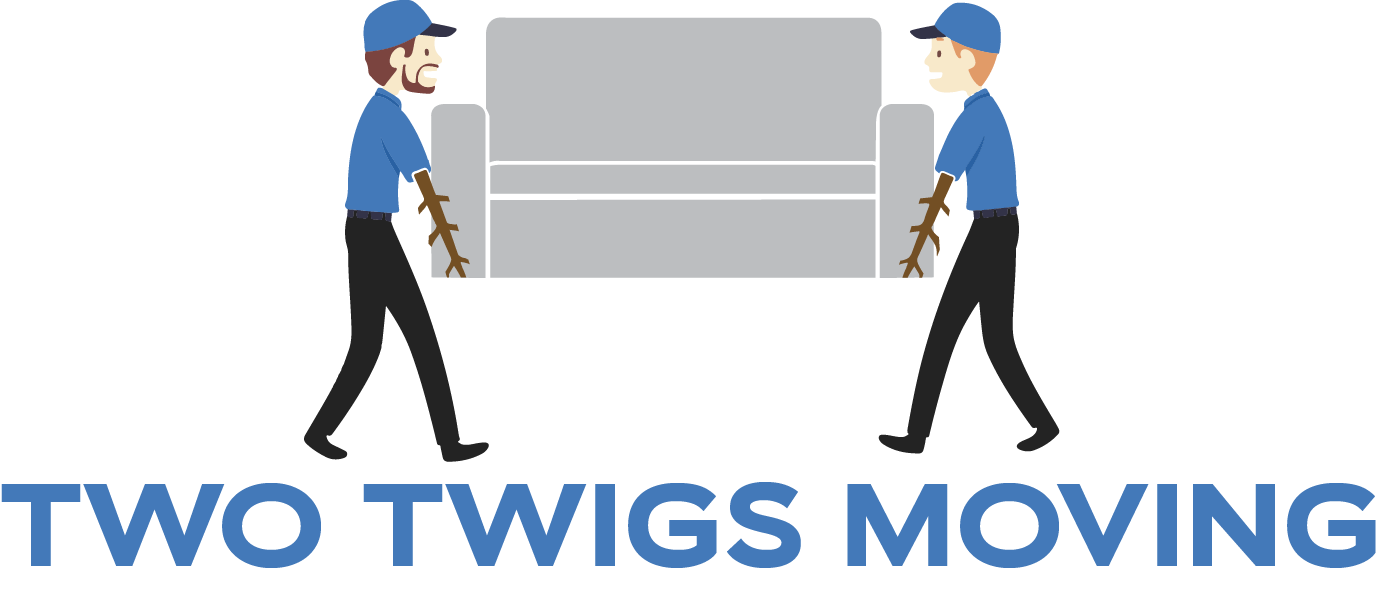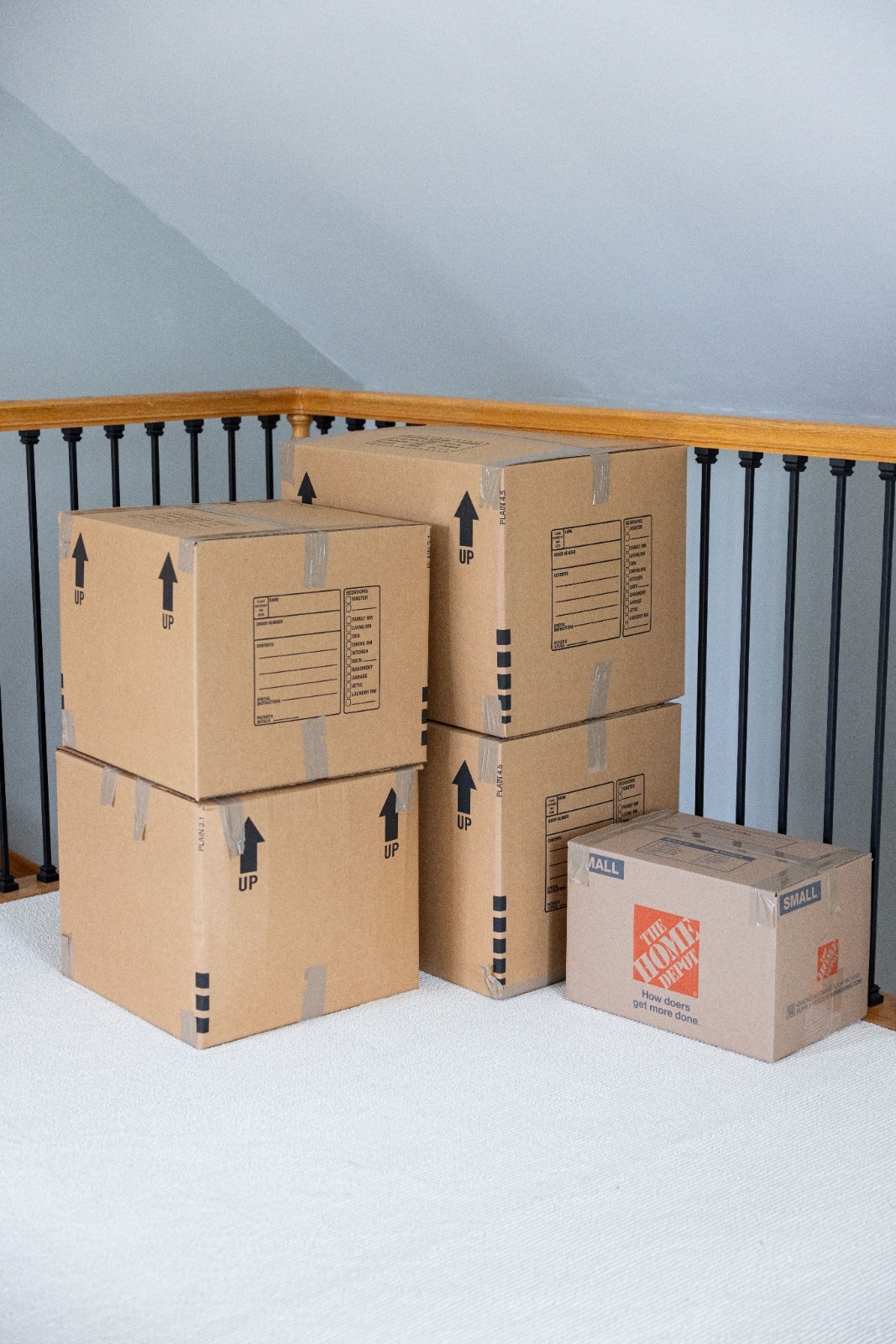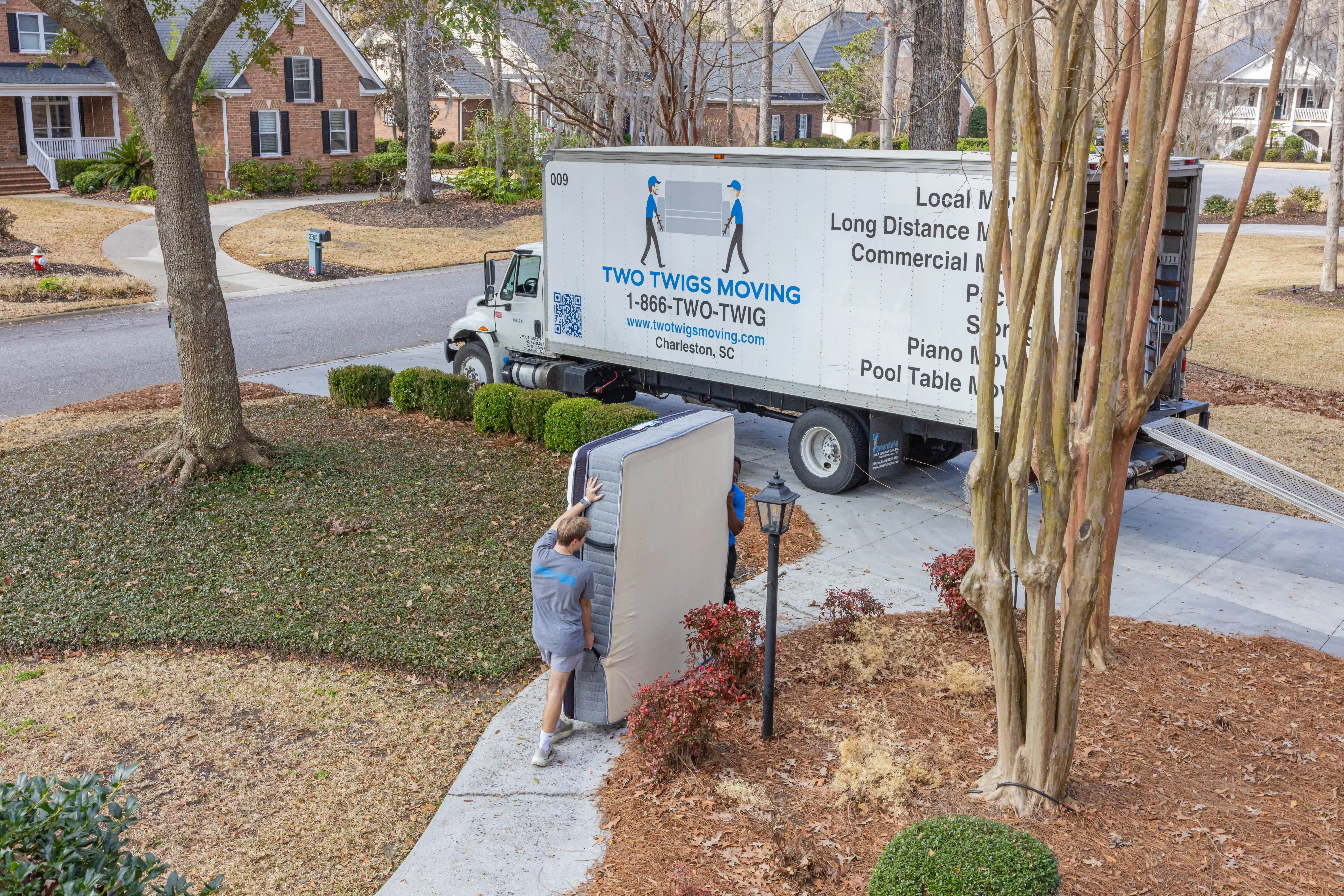Packing fragile items can feel overwhelming, but with the right approach, you can keep your valuables safe. Here’s what you need to know:
- Start with the right supplies: Use sturdy boxes, bubble wrap, packing paper, and strong tape. For extra security, consider specialty items like dividers for glassware or anti-static wrap for electronics.
- Wrap and cushion properly: Wrap each item individually with at least three layers of cushioning. Use padding to fill empty spaces in boxes to prevent shifting.
- Use smart packing techniques: Pack heavier items at the bottom, lighter ones on top, and label boxes with "FRAGILE" and "UP" arrows.
- Consider professional help: Movers bring expertise, high-quality materials, and insurance, reducing the risk of damage.
Whether you’re packing heirlooms, electronics, or artwork, taking these steps ensures your items arrive intact. For extra peace of mind, hiring professionals like Two Twigs Moving can make the process even easier and safer.
Packing Supplies You Need for Fragile Items
Using the right supplies is key to ensuring your fragile items stay safe during transit.
Essential Packing Materials
Sturdy boxes are the backbone of secure packing. For fragile items, corrugated boxes are your best bet. Lightweight items do fine in single-wall boxes, but heavier or more delicate pieces need double-wall or even triple-wall boxes. Pick a box that’s 10–25% larger than your item to allow for proper padding. As FedEx Packaging Experts explain:
"The right box does more than just fit tightly around your product. Your box should be sturdy enough to support your product’s weight and large enough to accommodate cushioning material."
Bubble wrap is a must-have for shock absorption. Use large bubbles for maximum impact protection and small bubbles to guard against surface scratches. Wrap items with the bubble side facing inward for better cushioning.
Packing paper is a budget-friendly option for padding and wrapping. While it doesn’t cushion as well as bubble wrap, it’s versatile and cost-effective. For instance, a 10-pound pack of uBoxes Newsprint Packing Paper costs about $25–$26.
Sturdy packing tape is essential for sealing boxes securely. Plan for about one roll per 15–20 boxes and reinforce the bottom seams for added strength.
Permanent markers make labeling easy and clear. Mark each box with "FRAGILE" in bold letters and use arrows to indicate which side should stay upright. A 12-pack of Sharpie Permanent Markers typically costs $10–$13.
For particularly valuable or delicate items, consider adding a few extra supplies to your packing arsenal.
Additional Supplies for Maximum Protection
Specialized boxes, such as TV boxes, dish packs, and mirror boxes, offer tailored protection for specific items. In October 2024, Experience.com highlighted the importance of these boxes for safeguarding high-value goods.
Cardboard dividers are perfect for keeping glassware separated and safe from contact damage. Similarly, foam corner protectors shield the edges of artwork and antiques from bumps and scrapes.
For electronics, anti-static bubble wrap protects against electrical damage, while furniture pads and moving blankets provide an extra layer of protection for larger items. You can find a 12-pack of moving blankets for roughly $130 on Amazon.
If you’re shipping extremely fragile or valuable items, monitoring tools can offer peace of mind. Tilt indicators reveal mishandling, humidity monitors protect moisture-sensitive items, and shock watches track any impacts during transit.
For fine art, use glassine paper as the first layer of protection before adding other materials. Electronics should have at least a 3-inch buffer of padding on all sides to prevent damage.
For one-of-a-kind or highly delicate items, custom crates provide the highest level of protection. These are especially useful for sculptures or other unique pieces but do come with a higher price tag.
The level of protection you choose should match the value and fragility of your items. While basic supplies work for most situations, investing in specialized materials for irreplaceable or high-value items is a smart move.
How to Pack Fragile Items Step by Step
Packing fragile items requires a methodical approach, starting with preparation and ending with clearly marked boxes that ensure safe handling.
Planning and Inventory
Before you start packing, take some time to declutter and create an inventory of your fragile items. This step not only reduces the number of things you’ll need to move but also helps you keep track of everything. Use a spreadsheet or a moving app to document your belongings, including furniture, electronics, and smaller fragile items. Assign categories to each item to make unpacking smoother and assist with any insurance claims, if necessary.
Gather all the packing supplies you’ll need – boxes, labels, markers, and inventory sheets. Pack one room at a time, grouping items by type, and update your master inventory list with the box number, room, and contents. A color-coding system can make identifying boxes even easier. Be sure to clearly label boxes containing delicate items with a "Fragile" sticker or marker, and note this in your inventory for quick reference.
Once your plan is set and supplies are ready, you can move on to wrapping each item securely.
Wrapping Methods for Different Items
Each fragile item has unique needs, so use wrapping techniques tailored to the type of object you’re packing:
- Glassware: Wrap each piece individually using packing paper or bubble wrap. Place heavier items at the bottom of the box and lighter ones on top. For wine glasses, pay special attention to wrapping the stems securely.
- Electronics: Back up your data and unplug devices at least 24 hours before packing to allow them to cool. Use the original packaging if available, as it’s designed for safe transport. If not, wrap electronics in bubble wrap or clean towels, and pack removable parts separately with extra cushioning.
- Ceramics: Focus on fragile areas like handles, spouts, or decorative elements, and add extra padding. Wrap each piece in three to five layers of bubble wrap, with the bubbles facing inward for better protection. Sharp corners may require additional padding.
"The packing process should be smooth and considered to protect every fragile object and beloved item from becoming damaged during relocation chaos." – Alliance Moving & Storage
For all fragile items, wrap them individually with at least three inches of cushioning. Use materials like bubble wrap, packing paper, newspaper, or even clean towels to prevent damage.
Boxing and Padding Methods
Choose sturdy boxes that can support the weight of your items while allowing room for cushioning. For extra protection, consider the double-boxing method: place the wrapped item in a smaller box, then put that box inside a larger one with about three inches of padding between them.
Start by lining the bottom of each box with soft materials like packing paper, bubble wrap, foam, or towels. Place heavier items at the bottom for stability, then layer lighter ones on top. Keep items centered in the box and ensure there’s cushioning on all sides to minimize movement during transit.
- Plates: Pack vertically to reduce the risk of breakage.
- Glasses and Stemware: Use dividers to keep them from colliding.
- Hollow Items (e.g., vases): Fill them with packing paper to absorb vibrations.
Dish packs – special boxes with thicker walls – are ideal for protecting valuable china or delicate dishware. Fill any empty spaces in the box with packing peanuts, crumpled newspaper, or similar materials to prevent shifting. As Alliance Moving & Storage notes, using packing peanuts can help absorb shocks and vibrations during the move.
"Investing in packaging up front and making sure you’ve followed our recommended best practices are the best ways to ensure your fragile items are delivered safely." – FedEx
Labeling and Safe Handling
Proper labeling is essential for keeping fragile items safe. Mark all sides of the box – not just the top – with "FRAGILE" in bold letters. Add arrows to indicate which side should remain upright.
Number each box and update your inventory list for easy tracking. Clear labeling not only helps with organization but also signals to movers to handle these boxes with care.
When lifting and moving boxes, use proper techniques to avoid sudden impacts. Secure each box with plenty of packing tape, and test the weight before sealing. If a box feels too heavy, redistribute the contents to prevent accidents or damage during handling.
Packing Tips for Special or High-Value Fragile Items
When it comes to fragile items that hold significant monetary or sentimental value, standard packing methods often fall short. High-value electronics, cherished family heirlooms, artwork, and uniquely shaped objects demand extra attention to ensure they arrive intact at your new home.
Custom Boxes and Double-Boxing
Standard boxes might work for everyday items, but when you’re dealing with fragile or high-value possessions, custom solutions are often the way to go. Custom boxes are tailored to fit specific items, offering a level of security that generic boxes simply can’t provide. For added protection, consider double-boxing. To do this, choose an outer box that’s at least 6 inches larger in every dimension than the inner box, allowing for a 3-inch cushioning layer on all sides.
For delicate ceramics or similarly fragile objects, custom laser-cut foam inserts inside a wooden crate provide maximum protection. While this option can be expensive, a more budget-conscious alternative involves using 2-inch plastazote foam sheets. Start by wrapping each piece in bubble wrap, then cut the foam to fit snugly around the item. Fill any remaining gaps with crumpled newsprint. For oddly shaped items, wrap narrow parts with bubble wrap until they are evenly padded, then continue wrapping until the item’s shape is no longer recognizable. Add a thick layer of crumpled paper at the bottom of the box, and ensure all voids are filled to prevent movement during transit.
These specialized methods are designed to safeguard items that are not only valuable but often irreplaceable.
Packing Sentimental or Irreplaceable Items
When packing items with deep personal significance, meticulous care is critical. These are not the belongings to skimp on when it comes to packing materials. Invest in high-quality supplies like acid-free paper, bubble wrap, and sturdy boxes to ensure maximum protection.
For glass items, wrap each piece first in packing paper, then in bubble wrap, and use crumpled paper or foam peanuts to fill any gaps inside the box. Before packing, clean each fragile item to remove dust or residue, and ensure they are completely dry to prevent mold or water damage during the move. Secure any loose parts, such as clock pendulums or chandelier arms, with soft padding. For hollow items like vases, stuff them with soft packing paper to provide internal support.
Clearly label all boxes containing fragile items with words like "fragile" or "very important" to ensure careful handling. When possible, pack delicate items vertically rather than horizontally, as this orientation offers better stability during transport. For items that are truly irreplaceable, consider transporting them yourself. As Bein Steinsholt, owner of Steinsholt Delivery, advises:
"Placing them on a moving truck opens the door to lots of movement, or the box not being handled with care. In the car with you will provide the safest way to get the item to its new home."
For sentimental items like photographs, letters, or important documents, create digital backups before packing them. This ensures you have copies in case anything gets lost or damaged. For extremely valuable or challenging items, hiring professional packing services can be a worthwhile investment, offering expert care and priceless peace of mind.
Whether you’re using a local moving company or planning a long-distance move, these tips can help ensure your most treasured belongings make it to your new home safely and securely.
sbb-itb-a5538b6
Benefits of Hiring Professional Moving Services
When it comes to safeguarding fragile items during a move, the choice often boils down to doing it yourself or hiring professionals. While DIY packing might initially seem like the cheaper option, the risks it carries – especially for delicate and valuable possessions – can outweigh the savings. Professional moving services, on the other hand, offer a range of advantages that can make the entire process smoother and more secure.
DIY Packing vs. Professional Movers: A Side-by-Side Look
The table below highlights the key differences between DIY packing and hiring professional movers, making it clear why experts are often the better choice.
| Factor | DIY Packing | Professional Movers |
|---|---|---|
| Cost | Lower upfront cost, but higher risk of damage | Higher cost, but includes insurance for damages |
| Time Commitment | Time-intensive and physically demanding | Efficiently handled, saving time and effort |
| Materials Quality | Basic supplies that may not protect fragile items | Specialized, high-quality packing materials |
| Expertise Level | Limited experience with delicate items | Skilled professionals with proven techniques |
| Physical Demand | Exhausting and stressful | No physical strain on you |
| Risk of Damage | Greater likelihood of breakage | Minimal risk with expert handling |
| Insurance Coverage | May rely on homeowner’s insurance | Includes liability coverage for added security |
Professional movers bring specialized materials and techniques to the table, ensuring your belongings are packed and transported with care. Unlike store-bought supplies, their tools are designed to minimize breakage, giving you peace of mind during the move. Plus, their expertise saves you time, reduces stress, and even includes insurance protection – something DIY efforts can’t guarantee.
Why Two Twigs Moving Stands Out for Fragile Item Packing

Numbers and testimonials tell the story: Two Twigs Moving has built a reputation for excellence when it comes to protecting delicate belongings. With over 180 five-star reviews and an impressive 4.8 out of 5-star rating based on 202 reviews, their track record speaks volumes. In fact, 86% of reviewers recommend their services, underscoring their commitment to customer satisfaction.
What truly sets Two Twigs Moving apart is their personal touch. They treat your belongings as if they were their own. As Renaldo Prescott, a team member, puts it:
"I will take and protect your furniture and all belongings as if they were mine! I take pride in my work so I closely pay attention to every detail and make sure my job is done correctly with no hiccups! Two Twigs!!"
- Renaldo Prescott
Their team of trained professionals is equipped to handle even the most delicate and high-value items, ensuring a seamless and stress-free experience. Every mover is carefully vetted and trained to uphold their high standards, giving you confidence that your possessions are in capable hands.
Two Twigs Moving offers customizable service packages to fit your specific needs and budget. Whether you’re planning a residential move, relocating to a new apartment, or organizing an office move, they have the expertise to handle it all. Plus, their free moving quotes make it easy to plan ahead and avoid unexpected costs, ensuring your fragile items are protected without breaking the bank.
With Two Twigs Moving, you’re not just hiring movers – you’re partnering with a team that prioritizes care, precision, and customer satisfaction every step of the way.
Conclusion: Protecting Your Fragile Items for a Smooth Move
Packing up fragile belongings doesn’t have to be a nerve-wracking experience. With the right methods, quality materials, and careful handling, you can ensure your delicate items arrive safely at their destination.
To recap, this guide covered everything from essential supplies to effective packing techniques and the importance of clear labeling. For those looking for extra protection, specialized packing methods can add another layer of security.
It’s no secret that moving is often labeled as one of life’s most stressful events. While the DIY route might seem like a cheaper option, hidden expenses – like truck rentals, packing supplies, time off work, and the risk of damaged items – can quickly add up. That’s where professional movers come in. They offer the expertise and tools to handle your belongings safely, along with the added benefit of insurance for peace of mind. Letting experienced movers take the reins can significantly reduce the stress of moving.
For an even smoother experience, consider services like Two Twigs Moving. They understand how nerve-wracking it can be to trust someone with your fragile items. That’s why their team focuses on careful handling, transparent pricing with free quotes, and customizable service options to meet your unique needs. Whether you’re planning a local move, tackling a long-distance relocation, or need help with apartment moving, their trained professionals treat your belongings as if they were their own.
Don’t let worries about damage overshadow the excitement of a fresh start. By combining proper packing techniques with expert movers, you can kick off your new chapter without unnecessary stress. Ready to make your move worry-free? Reach out to Two Twigs Moving for a free quote and see how their expertise can keep your most cherished items safe during this important transition.
FAQs
What are the best materials to use when packing fragile items to avoid damage during a move?
To protect fragile items during a move, choosing the right packing materials is key. Bubble wrap works wonders for cushioning and absorbing shocks, while packing paper or foam sheets help fill empty spaces, keeping items from shifting around inside the box. For extra security, you can opt for double-walled boxes or even use foam inserts to shield delicate pieces like glassware or ceramics.
When packing, wrap each fragile item individually and make sure they’re snugly placed in the box to reduce movement. These straightforward steps can go a long way in ensuring your valuables make it to your new home safe and sound.
What’s the best way to pack electronics to prevent damage during a move?
When moving your electronics, protecting them properly is key. Start by wrapping each device in anti-static bubble wrap or placing them in anti-static bags to guard against static electricity. Add foam padding or packing peanuts to cushion the items, minimizing the chances of shocks or vibrations during transit. If you still have the original packaging, use it – those boxes are specifically designed to keep your devices secure.
Make sure to clearly label boxes as fragile and avoid stacking heavy items on top of them. To keep things organized and prevent damage to delicate connectors, pack cords and accessories separately in labeled bags. This simple step can save you a lot of hassle later.
What are the advantages of hiring Two Twigs Moving to pack and transport fragile items?
Hiring Two Twigs Moving to handle your fragile items means trusting professionals who know how to pack and transport delicate belongings with precision and care. Our team uses specialized techniques and top-tier materials to protect your valuables, helping you feel confident that everything will arrive safely.
On top of that, we take the stress out of moving by handling the packing process quickly and efficiently. Equipped with the right tools and expertise, we ensure your fragile items are delivered securely to your new home or office, making the entire experience easier and more seamless for you.


.svg)


